Aquatic Foods and Nutrition in the Pacific
Abstract
1. Introduction
2. Materials and Methods
2.1. The Pacific Island Region and Case Study Countries
2.2. Vanuatu
2.3. Solomon Islands
2.4. Nutrient Composition
2.5. Consumption Data
2.5.1. National Consumption of Aquatic Foods
2.5.2. Village-Level Food Consumption
2.6. Trade of Aquatic Foods
3. Results
3.1. Nutrient Composition of Aquatic Foods in the Pacific
3.2. National Consumption of Aqautic Foods
3.3. Individual Consumption
3.4. Movement of Nutrients from Aquatic Foods through Imports and Exports
3.4.1. Canned Fish
3.4.2. Oceanic Tuna Fishery
4. Discussion
4.1. Aquatic Food Is Not a Homogenous Group
4.2. Integrating Nutrient Compostion Information with Consumption Patterns
4.3. Aquatic Food as Part of the Pacific Food System
4.4. Effects of Aquatic Food Trade on Nutrition
4.4.1. Imports
4.4.2. Exports
4.5. Future Opportunities and Constraints for Aquatic Foods and Nutrition
4.5.1. Data Gaps
4.5.2. Addressing the Predicted Supply Gap from Coastal Fisheries
4.5.3. Addressing Contaminants
5. Conclusions
Supplementary Materials
Author Contributions
Funding
Acknowledgments
Conflicts of Interest
References
- Bell, J.D.; Kronen, M.; Vunisea, A.; Nash, W.J.; Keeble, G.; Demmke, A.; Pontifex, S.; Andréfouët, S. Planning the use of fish for food security in the Pacific. Mar. Policy 2009, 33, 64–76. [Google Scholar] [CrossRef]
- FAO. Global Blue Growth Initiative and Small Island Developing States; Food and Agriculture Organization of the United Nations: Rome, Italy, 2014. [Google Scholar]
- Gillet, R. Fisheries in the Economies of Pacifi Island Countries and Territories; Pacific Community: Noumea, New Caledonia, 2016. [Google Scholar]
- Thilsted, S.H.; Thorne-Lyman, A.; Webb, P.; Bogard, J.R.; Subasinghe, R.; Phillips, M.J.; Allison, E.H. Sustaining healthy diets: The role of capture fisheries and aquaculture for improving nutrition in the post-2015 era. Food Policy 2016, 61, 126–131. [Google Scholar] [CrossRef]
- WHO. Global Status Report on Noncommunicable Diseases 2014; World Health Organization: Geneva, Switzerland, 2014. [Google Scholar]
- Haddad, L.; Cameron, L.; Barnett, I. The double burden of malnutrition in SE Asia and the Pacific: Priorities, policies and politics. Health Policy Plan. 2015, 30, 1193–1206. [Google Scholar] [CrossRef] [PubMed]
- WHO. The Global Prevalence of Anaemia in 2011; World Health Organization: Geneva, Switzerland, 2015. [Google Scholar]
- United Nations Children’s Fund. Situation Analysis of Children in the Pacific Island Countries; UNICEF: Suva, Fiji, 2017. [Google Scholar]
- Sievert, K.; Lawrence, M.; Naika, A.; Baker, P. Processed foods and nutrition transition in the Pacific: Regional trends, patterns and food system drivers. Nutrients 2019, 11, 1328. [Google Scholar] [CrossRef]
- Fanzo, J.; Hawkes, C.; Udomkesmalee, E.; Afshin, A.; Allemandi, L.; Assery, O.; Baker, P.; Battersby, J.; Bhutta, Z.; Chen, K. 2018 Global Nutrition Report: Shining a Light to Spur Action on Nutrition; Development Initiatives: Bristol, UK, 2018. [Google Scholar]
- Hughes, R.G.; Lawrence, M. Globalisation, food and health in Pacific Island countries. Asia Pacific J. Clin. Nutr. 2005, 14, 298–305. [Google Scholar]
- Andersen, A.B.; Thilsted, S.H.; Schwarz, A.M. Food and Nutrition Security in Solomon Islands; Working Paper, AAS-2013-06; WorldFish: Penang, Malaysia, 2013; p. 15. [Google Scholar]
- Hawley, N.L.; McGarvey, S.T. Obesity and diabetes in Pacific Islanders: The current burden and the need for urgent action. Curr. Diabetes Rep. 2015, 15, 29. [Google Scholar] [CrossRef]
- United Nations Population Fund. Population and Development Profiles: Pacific Island Countries; UNFPA Pacific Sub-Regional Office: Suva, Fiji, 2014. [Google Scholar]
- Thow, A.M.; Snowdon, W. The effect of trade and trade policy on diet and health in the Pacific Islands. Trade Food Diet Health Perspect. Policy Options 2010, 147, 168. [Google Scholar]
- Horsey, B.; Swanepoel, L.; Underhill, S.; Aliakbari, J.; Burkhart, S. Dietary diversity of an adult Solomon Islands population. Nutrients 2019, 11, 1622. [Google Scholar] [CrossRef]
- Popkin, B.M.; Horton, S.; Kim, S. The nutrition Transition and Prevention of Diet-Related Chronic Diseases in Asia and the Pacific. Food Nutr. Bull. 2012, 22, 1–58. [Google Scholar]
- Charlton, K.E.; Russell, J.; Gorman, E.; Hanich, Q.; Delisle, A.; Campbell, B.; Bell, J. Fish, food security and health in Pacific Island countries and territories: A systematic literature review. BMC Public Health 2016, 16, 285. [Google Scholar] [CrossRef]
- Li, M.; McKelleher, N.; Moses, T.; Mark, J.; Byth, K.; Ma, G.; Eastman, C.J. Iodine nutritional status of children on the island of Tanna, Republic of Vanuatu. Public Health Nutr. 2009, 12, 1512–1518. [Google Scholar] [CrossRef] [PubMed]
- Dancause, K.N.; Dehuff, C.; Soloway, L.E.; Vilar, M.; Chan, C.; Wilson, M.; Tarivonda, L.; Regenvanu, R.; Kaneko, A.; Garruto, R.M. Behavioral changes associated with economic development in the South Pacific: Health transition in Vanuatu. Am. J. Hum. Biol. 2011, 23, 366–376. [Google Scholar] [CrossRef] [PubMed]
- Dancause, K.N.; Vilar, M.; Wilson, M.; Soloway, L.E.; DeHuff, C.; Chan, C.; Tarivonda, L.; Regenvanu, R.; Kaneko, A.; Lum, J.K. Behavioral risk factors for obesity during health transition in Vanuatu, South Pacific. Obesity 2013, 21, E98–E104. [Google Scholar] [CrossRef] [PubMed][Green Version]
- Mertz, O.; Bruun, T.B.; Fog, B.; Rasmussen, K.; Agergaard, J. Sustainable land use in Tikopia: Food production and consumption in an isolated agricultural system. Singap. J. Trop. Geogr. 2010, 31, 10–26. [Google Scholar] [CrossRef]
- Aswani, S.; Furusawa, T. Do marine protected areas affect human nutrition and health? A comparison between villages in Roviana, Solomon Islands. Coast. Manag. 2007, 35, 545–565. [Google Scholar] [CrossRef]
- Albert, J.A.; Beare, D.; Schwarz, A.M.; Albert, S.; Warren, R.; Teri, J.; Siota, F.; Andrew, N.L. The contribution of nearshore fish aggregating devices (FADs) to food security and livelihoods in Solomon Islands. PLoS ONE 2014, 9, e115386. [Google Scholar] [CrossRef]
- Albert, J.; Bogard, J.; Siota, F.; McCarter, J.; Diatalau, S.; Maelaua, J.; Brewer, T.; Andrew, N. Malnutrition in rural Solomon Islands: An analysis of the problem and its drivers. Matern. Child Nutr. 2020, 16, e12921. [Google Scholar] [CrossRef]
- Bell, J.D.; Ganachaud, A.; Gehrke, P.C.; Griffiths, S.P.; Hobday, A.J.; Hoegh-Guldberg, O.; Johnson, J.E.; le Borgne, R.; Lehodey, P.; Lough, J.M. Mixed responses of tropical Pacific fisheries and aquaculture to climate change. Nat. Clim. Chang. 2013, 3, 591–599. [Google Scholar] [CrossRef]
- Andrew, N.; Campbell, B.; Delisle, A.; Li, O.; Neihapi, P.; Nikiara, B.; Sami, A.; Steenbergen, D.; Urium, T. Developing Participatory Monitoring of Community Fisheries in Kiribati and Vanuatu; SPC Fisheries Newsletter #162: Noumea, New Caledonia, 2020. [Google Scholar]
- Tilley, A.; Burgos, A.; Duarte, A.; dos Reis Lopes, J.; Eriksson, H.; Mills, D. Contribution of women’s fisheries substantial, but overlooked, in Timor-Leste. Ambio 2020. [Google Scholar] [CrossRef]
- SPC. Status Report: Pacific Islands Reef and Nearshore Fisheries and Aquaculture; SPC: Noumea, New Caledonia, 2013. [Google Scholar]
- Pratchett, M.S.; Munday, P.L.; Graham, N.A.; Kronen, M.; Pinca, S.; Friedman, K.; Brewer, T.D.; Bell, J.D.; Wilson, S.K.; Cinner, J.E.; et al. Vulnerability of coastal fisheries. In Vulnerability of Tropical Pacific Fisheries and Aquaculture to Climate Change; Bell, J.D., Johnson, J.E., Hobday, A.J., Eds.; Secretariat of the Pacific Community: Noumea, New Caledonia, 2011; pp. 167–185. [Google Scholar]
- Gillett, R.; Tauati, M.I. Fisheries of the Pacific Islands: Regional and National Information; Fisheries and Aquaculture Technical Paper; FAO: Rome, Italy, 2018; pp. 1–47. [Google Scholar]
- Pickering, T.D.; Ponia, B.; Hair, C.A.; Southgate, P.C.; Poloczanska, E.; Patrona, L.; Teitelbaum, A.; Mohan, C.V.; Phillips, M.J.; Bell, J.D. Vulnerability of Aquaculture in the Tropical Pacific to Climate Change; Secretariat of the Pacific Community: Noumea, New Caledonia, 2011. [Google Scholar]
- Hambrey, J.; Govan, H.; Carleton, C. Opportunities for the development of the Pacific islands’ mariculture sector. In Report to the Secretariat of the Pacific Community by Hambrey Consulting; SPC: Noumea, New Caledonia, 2012; ISBN 978-982-00-0529-7. [Google Scholar]
- Paul, N. Diversification of Seaweed Industries in Pacific Island Countries: Final Report FIS/2010/098; Australian Centre for International Agricultural Research: Canberra, Australia, 2020. [Google Scholar]
- Farmery, A.K.; O’Kane, G.; McManus, A.; Green, B.S. Consuming sustainable seafood: Guidelines, recommendations and realities. Public Health Nutr. 2018, 21, 1503–1514. [Google Scholar] [CrossRef]
- Black, R.E.; Victora, C.G.; Walker, S.P.; Bhutta, Z.A.; Christian, P.; de Onis, M.; Ezzati, M.; Grantham-McGregor, S.; Katz, J.; Martorell, R. Maternal and child undernutrition and overweight in low-income and middle-income countries. Lancet 2013, 382, 427–451. [Google Scholar] [CrossRef]
- Hicks, C.C.; Cohen, P.J.; Graham, N.A.; Nash, K.L.; Allison, E.H.; D’Lima, C.; Mills, D.J.; Roscher, M.; Thilsted, S.H.; Thorne-Lyman, A.L. Harnessing global fisheries to tackle micronutrient deficiencies. Nature 2019, 574, 95–98. [Google Scholar] [CrossRef]
- Eriksson, H.; Friedman, K.; Amos, M.; Bertram, I.; Pakoa, K.; Fisher, R.; Andrew, N. Geography limits island small-scale fishery production. Fish Fish. 2018, 19, 308–320. [Google Scholar] [CrossRef]
- Farrell, P.; Thow, A.M.; Wate, J.T.; Nonga, N.; Vatucawaqa, P.; Brewer, T.; Sharp, M.K.; Farmery, A.; Trevena, H.; Reeve, E. COVID-19 and Pacific food system resilience: Opportunities to build a robust response. Food Secur. 2020, 12, 783–791. [Google Scholar] [CrossRef] [PubMed]
- Andrew, N.L.; Bright, P.; de la Rua, L.; Teoh, S.J.; Vickers, M. Coastal proximity of populations in 22 Pacific Island Countries and Territories. PLoS ONE 2019, 14, e0223249. [Google Scholar] [CrossRef]
- SPC. Pacific Island Populations (Les Populations du Pacifique) 2020; The Pacific Community (SPC): Noumea, New Caledonia, 2020. [Google Scholar]
- Schapper, A. Linguistic Melanesia. In The Routledge Handbook of Language Contact; Matras, A.A.Y., Ed.; Routledge: New York, NY, USA, 2020. [Google Scholar]
- Govan, H.; Tawake, A.; Tabunakawai, K.; Jenkins, A.; Lasgorceix, A.; Techera, E.; Tafea, H.; Kinch, J.; Feehely, J.; Ifopo, P. Community Conserved Areas: A review of status & needs in Melanesia and Polynesia. In ICCA Regional Review for CENESTA/TILCEPA/TGER/IUCN/GEF—SGP; IUCN: Gland, Switzerland, 2009; 66p. [Google Scholar]
- DESA. World Population Prospects 2019. Available online: https://population.un.org/wpp/Download/Standard/Population/ (accessed on 17 November 2020).
- Day, J.; Forster, T.; Himmelsbach, J.; Korte, L.; Mucke, P.; Radtke, K.; Thielbörger, P.; Weller, D. World Risk Report 2019; Bündnis Entwicklung Hilft and Ruhr University Bochum–Institute for International Law of Peace and Armed Conflict (IFHV): Berlin, Germany, 2019. [Google Scholar]
- FAO. AQUASTAT Country Profile–Vanuatu; Food and Agriculture Organization of the United Nations FAO: Rome, Italy, 2016. [Google Scholar]
- World Bank. Country Profile Vanuatu. In World Development Indicators Database; World Bank: Washington, DC, USA, 2019. [Google Scholar]
- VNSO. Vanuatu Household Income and Expenditure Survey 2010; Vanuatu National Statistics Office: Port Vila, Vanuatu, 2012. [Google Scholar]
- Government of Vanuatu. Vanuatu National Plan of Action on Food and Nutrition Security; National Advosry Board on Climate Change and Disaster Risk Reduction: Port Vila, Vanuatu, 2013. [Google Scholar]
- Bank, W. Solomon Islands Systematic Country Diagnostic: Priorities for Supporting Poverty Reduction and Promoting Shared Prosperity; World Bank: Washington, DC, USA, 2017. [Google Scholar]
- UNDP. Human Development Indices and Indicators: 2018 Statisticalupdate; United Nations Development Program: New York, NY, USA, 2018. [Google Scholar]
- SIG. Solomon Islands Poverty Profile Based on the 2012/13 Household Income and Expenditure Survey; Solomon Islands Government: Honiara, Solomon Islands, 2015. [Google Scholar]
- Hoy, C. Poverty and the pandemic in the Pacific. In Devpolicy Blog; Betteridge, S.H.A.A., Ed.; The Australian National University: Canberra, Australia, 2020; Volume 2020. [Google Scholar]
- Woo, S.; Perera Mubarak, K.N.; Mahmood, N.L.; Ride, A.K.; Naidoo, D.; Ki’l, M.; Resture, M.; Aluta, R.; Funa, J. Enhancing the Economic Participation of Vulnerable Young Women in Solomon Islands; The World Bank: Washington, DC, USA, 2019. [Google Scholar]
- SIG. Report on National Agricultural Survey 2017; Solomon Islands Government, National Statistics Office: Honiara, Solomon Islands, 2019. [Google Scholar]
- SINSO. Solomon Islands 2012–2013 Household Income and Expenditure Survey: National Report; Solomon Islands National Statistics Office: Honiara, Solomon Islands, 2013. [Google Scholar]
- SPC; UOW; FAO. The Pacific Nutrient Database User Guide: A Tool to Facilitate the Analysis of Poverty, Nutrition and Food Security in the Pacific Region; Pacific Community, University of Wollongong and the Food and Agriculture Organization of the United Nations: Noumea, New Caledonia, 2020; p. 15. [Google Scholar]
- Aakre, I.; Næss, S.; Kjellevold, M.; Markhus, M.W.; Alvheim, A.R.; Dalane, J.Ø.; Kielland, E.; Dahl, L. New data on nutrient composition in large selection of commercially available seafood products and its impact on micronutrient intake. Food Nutr. Res. 2019, 63. [Google Scholar] [CrossRef]
- Nordhagen, A.; Rizwan, A.A.M.; Aakre, I.; Moxness Reksten, A.; Pincus, L.M.; Bøkevoll, A.; Mamun, A.; Haraksingh Thilsted, S.; Htut, T.; Somasundaram, T. Nutrient Composition of Demersal, Pelagic, and Mesopelagic Fish Species Sampled Off the Coast of Bangladesh and Their Potential Contribution to Food and Nutrition Security—The EAF-Nansen Programme. Foods 2020, 9, 730. [Google Scholar] [CrossRef]
- Fiedler, J.L.; Lividini, K.; Bermudez, O.I.; Smitz, M.F. Household Consumption and Expenditures Surveys (HCES): A primer for food and nutrition analysts in low-and middle-income countries. Food Nutr. Bull. 2012, 33, S170–S184. [Google Scholar] [CrossRef]
- Fiedler, J.L.; Carletto, C.; Dupriez, O. Still waiting for Godot? Improving Household Consumption and Expenditures Surveys (HCES) to enable more evidence-based nutrition policies. Food Nutr. Bull. 2012, 33, S242–S251. [Google Scholar] [CrossRef]
- FAO. Minimum Dietary Diversity for Women: A Guide for Measurement; FAO: Rome, Italy, 2016; p. 82. [Google Scholar]
- Kastom Garden Association. People on the Edge. A Report of the 2005 Kastom Gaden Association Assessment of the Food Security, Livelihoods Potential and Energy Resources of the Guadalcanal Weather Coast, Solomon Islands; Kastom Garden Association: Rockdale, Australia, 2005. [Google Scholar]
- Bell, J.D.; Reid, C.; Batty, M.J.; Lehodey, P.; Rodwell, L.; Hobday, A.J.; Johnson, J.E.; Demmke, A. Effects of climate change on oceanic fisheries in the tropical Pacific: Implications for economic development and food security. Clim. Chang. 2013, 119, 199–212. [Google Scholar] [CrossRef]
- Bell, J.D.; Sharp, M.K.; Havice, E.; Batty, M.; Charlton, K.E.; Russell, J.; Adams, W.; Azmi, K.; Romeo, A.; Wabnitz, C.C. Realising the food security benefits of canned fish for Pacific Island countries. Mar. Policy 2019, 100, 183–191. [Google Scholar] [CrossRef]
- Brewer, T.D.; Andrew, N.L.; Sharp, M.K.; Thow, A.; Kottage, H.; Jones, S. A Method for Cleaning Trade Data for Regional Analysis: The Pacific Food Trade Database (Version 2, 1995–2018); Pacific Community Working Paper; SPC: Noumea, New Caledonia, 2020. [Google Scholar]
- Gaulier, G.; Zignago, S. Baci: International Trade Database at the Product-Level (The 1994–2007 Version). Paris, France; 2010. Available online: https://ssrn.com/abstract=1994500 (accessed on 26 November 2020).
- FAO. The State of World Fisheries and Aquaculture 2020. Sustainability in Action; Food and Agriculture Organization of the United Nations: Rome, Italy, 2020. [Google Scholar]
- Bell, J.D.; Allain, V.; Allison, E.H.; Andréfouët, S.; Andrew, N.L.; Batty, M.J.; Blanc, M.; Dambacher, J.M.; Hampton, J.; Hanich, Q. Diversifying the use of tuna to improve food security and public health in Pacific Island countries and territories. Mar. Policy 2015, 51, 584–591. [Google Scholar] [CrossRef]
- Scherf, B.D. World Watch List for Domestic Animal Diversity; Food and Agriculture Organization (FAO): Rome, Italy, 2000. [Google Scholar]
- Roos, N.; Wahab, M.A.; Hossain, M.A.R.; Thilsted, S.H. Linking human nutrition and fisheries: Incorporating micronutrient-dense, small indigenous fish species in carp polyculture production in Bangladesh. Food Nutr. Bull. 2007, 28, S280–S293. [Google Scholar] [CrossRef] [PubMed]
- Farmery, A.K.; Hendrie, G.; O’Kane, G.; McManus, A.; Green, B. Sociodemographic variation in consumption patterns of sustainable and nutritious seafood in Australia. Front. Nutr. 2018, 5, 118. [Google Scholar] [CrossRef]
- Moxness Reksten, A.; Bøkevoll, A.; Frantzen, S.; Lundebye, A.K.; Kögel, T.; Kolås, K.; Aakre, I.; Kjellevold, M. Sampling protocol for the determination of nutrients and contaminants in fish and other seafood–The EAF-Nansen Programme. Methods X 2020, 7, 101063. [Google Scholar] [CrossRef]
- SPC. Fish and Food Security; Secretariat of the Pacific Community: Noumea, New Caledonia, 2008. [Google Scholar]
- Cheng, M.H. Asia-Pacific faces diabetes challenge. Lancet 2010, 375, 2207–2210. [Google Scholar] [CrossRef]
- Cassels, S. Overweight in the Pacific: Links between foreign dependence, global food trade, and obesity in the Federated States of Micronesia. Glob. Health 2006, 2, 10. [Google Scholar] [CrossRef][Green Version]
- HLPE. Nutrition and Food Systems; High Level Panel of Experts on Food Security and Nutrition of the Committee on World Food Security: Rome, Italy, 2017. [Google Scholar]
- Coyne, T.; Hughes, R.; Langi, S. Lifestyle Diseases in Pacific Communities; Secretariat of the Pacific Community: Noumea, New Caledonia, 2000. [Google Scholar]
- Eriksson, H.; Ride, A.; Notere Boso, D.; Sukulu, M.; Batalofo, M.; Siota, F.; Gomese, C. Changes and Adaptations in Village Food Systems in Solomon Islands: A Rapid Appraisal during the Early Stages of the COVID-19 Pandemic; WorldFish: Honiara, Solomon Isalnds, 2020. [Google Scholar]
- Steenbergen, D.; Neihapi, P.; Koran, D.; Sami, A.; Malverus, V.; Ephraim, R.; Andrew, N. COVID-19 restrictions amidst cyclones and volcanoes: A rapid assessment of early impacts on livelihoods and food security in coastal communities in Vanuatu. Mar. Policy 2020, 121, 104199. [Google Scholar] [CrossRef]
- Eriksson, H.; Albert, J.; Albert, S.; Warren, R.; Pakoa, K.; Andrew, N. The role of fish and fisheries in recovering from natural hazards: Lessons learned from Vanuatu. Environ. Sci. Policy 2017, 76, 50–58. [Google Scholar] [CrossRef]
- Christoforou, A.; Snowdon, W.; Laesango, N.; Vatucawaqa, S.; Lamar, D.; Alam, L.; Lippwe, K.; Havea, I.L.; Tairea, K.; Hoejskov, P.; et al. Progress on Salt Reduction in the Pacific Islands: From Strategies to Action. Heart Lung Circ. 2015, 24, 503–509. [Google Scholar] [CrossRef]
- Asche, F.; Bellemare, M.; Roheim, C.; Smith, M.; Tveterås, S. Fair Enough? Food Security and the International Seafood Trade. World Dev. 2015, 67, 151–160. [Google Scholar] [CrossRef]
- Béné, C.; Lawton, R.; Allison, E.H. “Trade Matters in the Fight Against Poverty”: Narratives, Perceptions, and (Lack of) Evidence in the Case of Fish Trade in Africa. World Dev. 2010, 38, 933–954. [Google Scholar] [CrossRef]
- Nash, K.L.; MacNeil, M.A.; Blanchard, J.L.; Cohen, P.J.; Farmery, A.; Graham, N.A.J.; Thorne-Lyman, A.; Watson, R.; Hicks, C. Foreign fishing and trade mediate nutrient supply from fisheries. Nature. in review.
- Bell, J.D.; Cisneros-Montemayor, A.; Hanich, Q.; Johnson, J.E.; Lehodey, P.; Moore, B.R.; Pratchett, M.S.; Reygondeau, G.; Senina, I.; Virdin, J.; et al. Adaptations to maintain the contributions of small-scale fisheries to food security in the Pacific Islands. Mar. Policy 2018, 88, 303–314. [Google Scholar] [CrossRef]
- Asch, R.G.; Cheung, W.W.; Reygondeau, G. Future marine ecosystem drivers, biodiversity, and fisheries maximum catch potential in Pacific Island countries and territories under climate change. Mar. Policy 2018, 88, 285–294. [Google Scholar] [CrossRef]
- van der Ploeg, J.; Sukulu, M.; Govan, H.; Minter, T.; Eriksson, H. Sinking Islands, Drowned Logic; Climate Change and Community-Based Adaptation Discourses in Solomon Islands. Sustainability 2020, 12, 7225. [Google Scholar] [CrossRef]
- Hernández-Delgado, E.A. The emerging threats of climate change on tropical coastal ecosystem services, public health, local economies and livelihood sustainability of small islands: Cumulative impacts and synergies. Mar. Pollut. Bull. 2015, 101, 5–28. [Google Scholar] [CrossRef]
- FFA. A Regional Roadmap for Sustainable Pacific Fisheries. Available online: https://www.ffa.int/system/files/Roadmap_web_0.pdf (accessed on 21 May 2020).
- Houssard, P.; Point, D.; Tremblay-Boyer, L.; Allain, V.; Pethybridge, H.; Masbou, J.; Ferriss, B.E.; Baya, P.A.; Lagane, C.; Menkes, C.E. A model of mercury distribution in tuna from the western and central Pacific Ocean: Influence of physiology, ecology and environmental factors. Environ. Sci. Technol. 2019, 53, 1422–1431. [Google Scholar] [CrossRef]
- FSANZ. Advice on Fish Consumption: Mercury in Fish. Availabe online:. Available online: http://www.foodstandards.gov.au/consumer/chemicals/mercury/Pages/default.aspx (accessed on 25 February 2020).
- Médieu, A.; Point, D.; Receveur, A.; Gauthier, O.; Allain, V.; Pethybridge, H.; Menkes, C.E.; Gillikin, D.P.; Revill, A.T.; Somes, C.J. Stable mercury concentrations of tropical tuna in the south western Pacific ocean: An 18-year monitoring study. Chemosphere 2020, 263, 128024. [Google Scholar] [CrossRef]
- Friedman, M.A.; Fernandez, M.; Backer, L.C.; Dickey, R.W.; Bernstein, J.; Schrank, K.; Kibler, S.; Stephan, W.; Gribble, M.O.; Bienfang, P. An updated review of ciguatera fish poisoning: Clinical, epidemiological, environmental, and public health management. Mar. Drugs 2017, 15, 72. [Google Scholar] [CrossRef]
- Skinner, M.P.; Brewer, T.D.; Johnstone, R.; Fleming, L.E.; Lewis, R.J. Ciguatera fish poisoning in the Pacific Islands (1998 to 2008). PLoS Negl. Trop Dis. 2011, 5, e1416. [Google Scholar] [CrossRef] [PubMed]
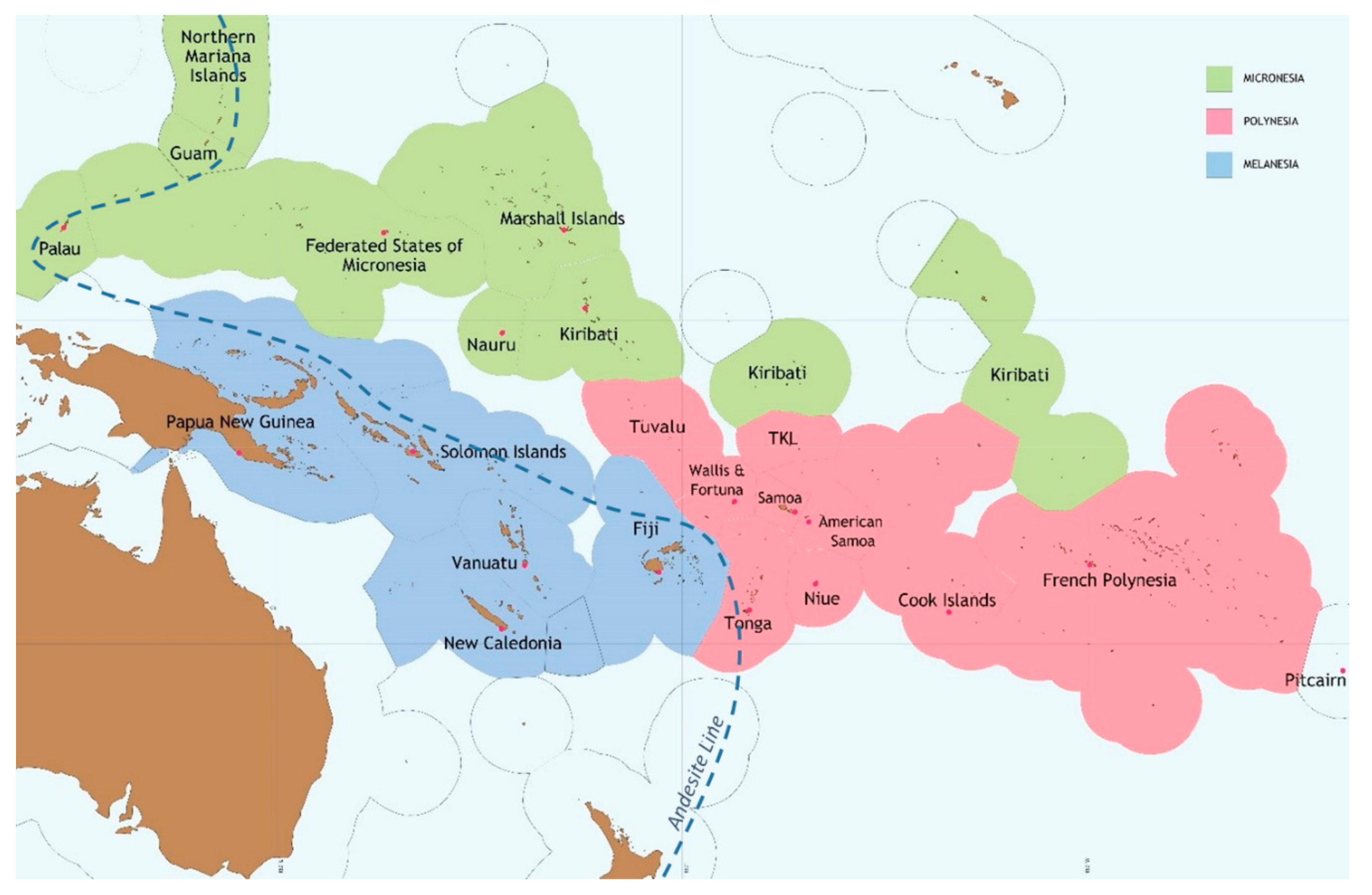
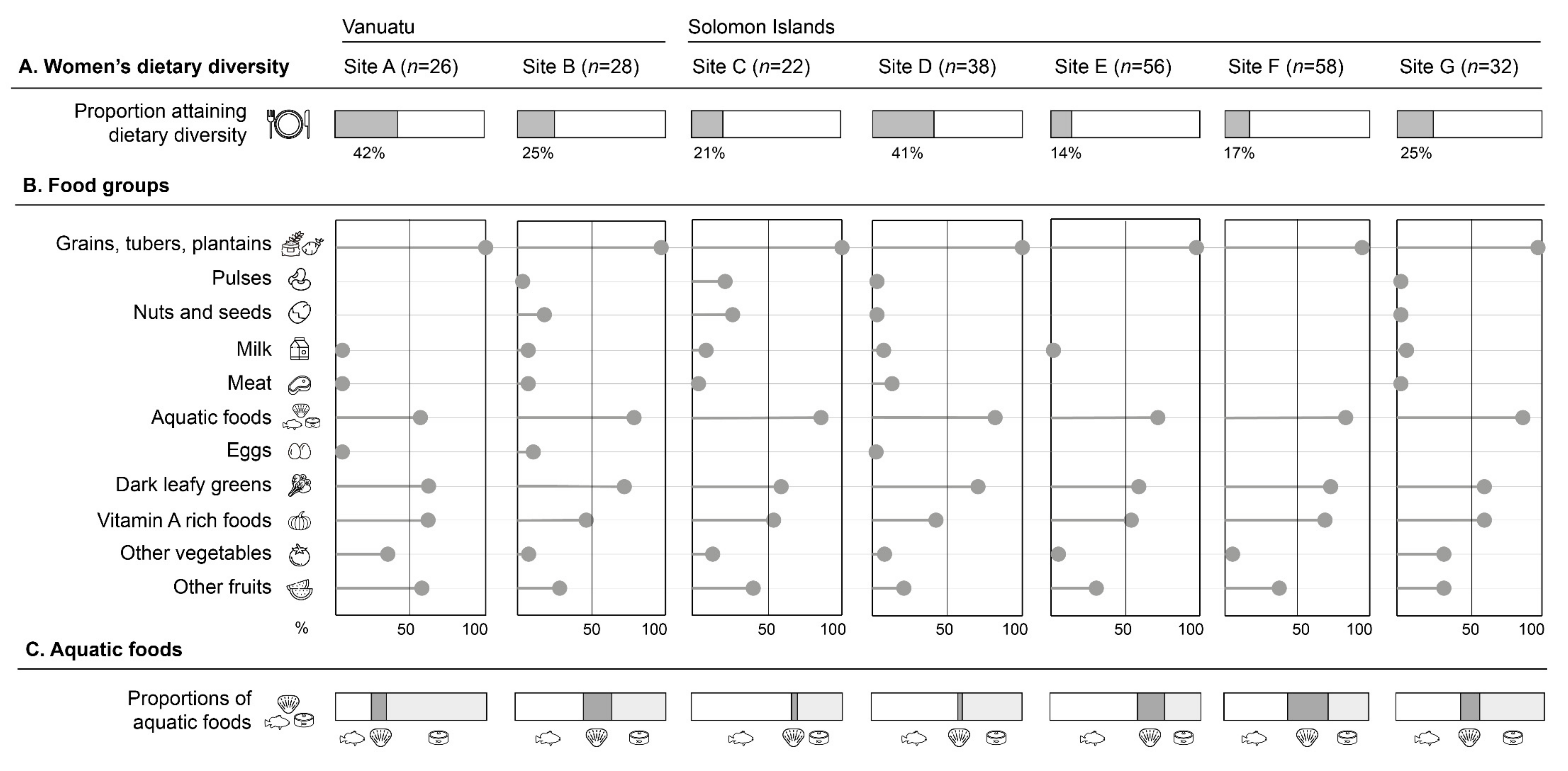
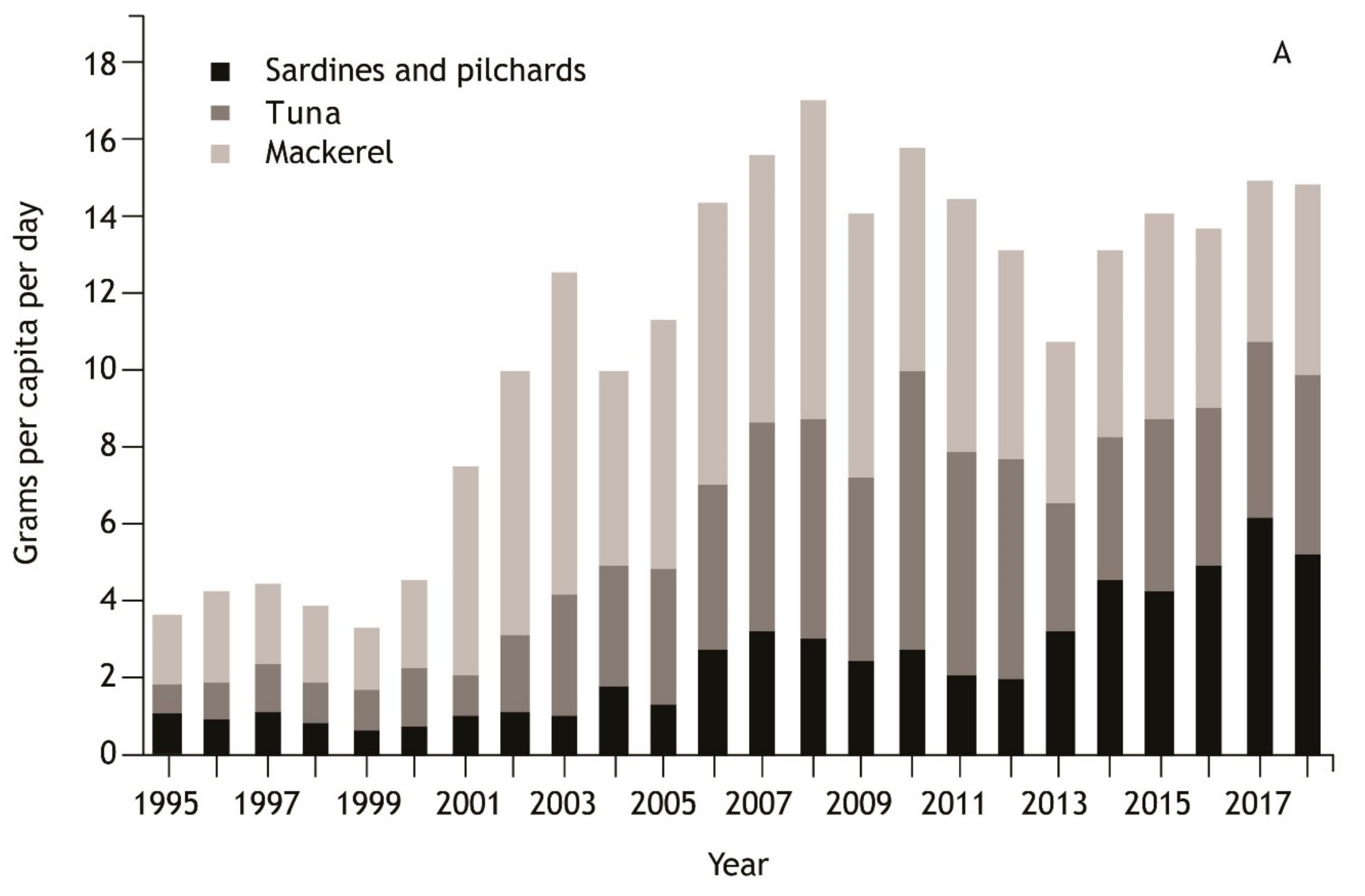
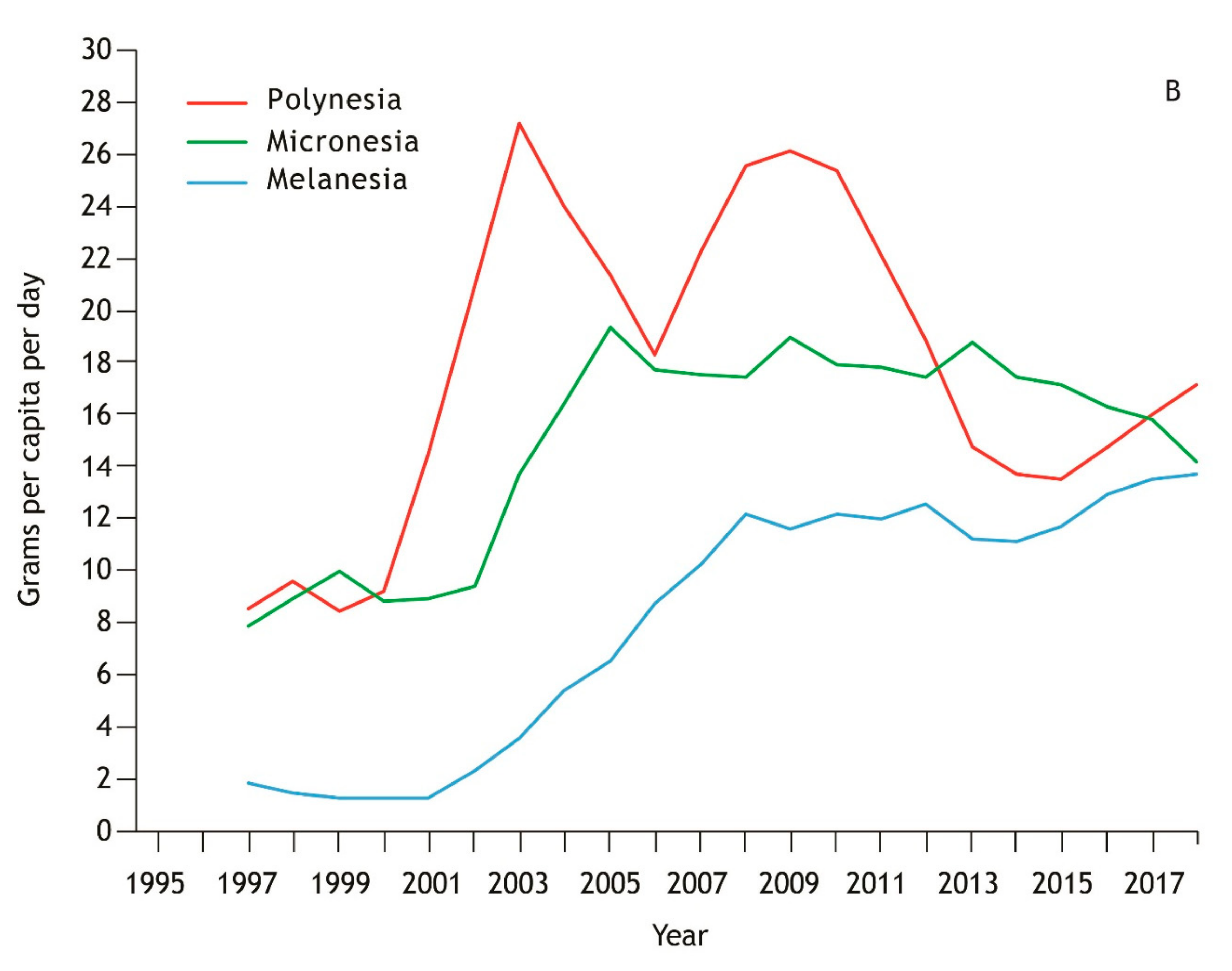
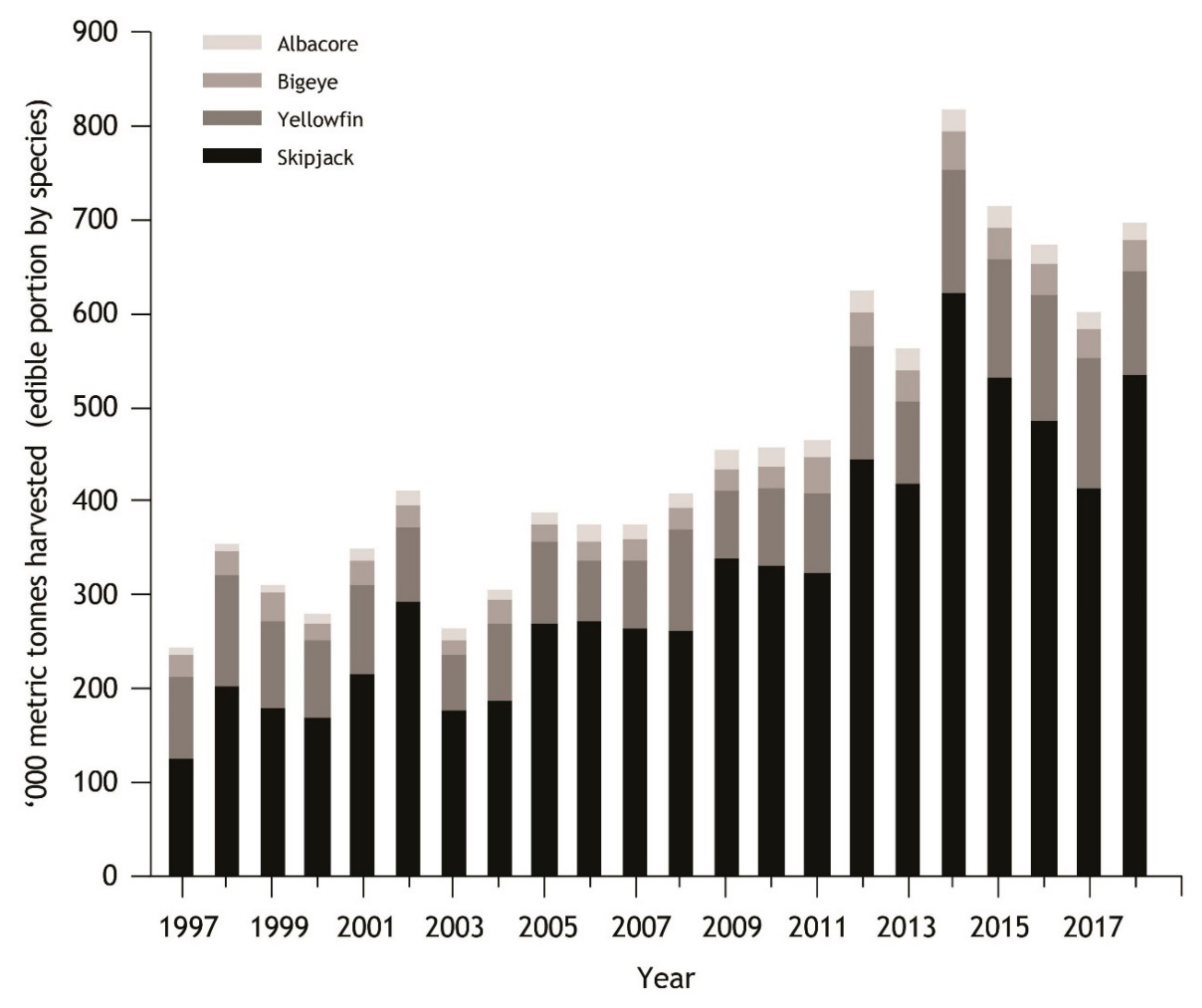
| Aquatic Food Group | Energy (kcal) | Protein (g) | Fat (g) | Sodium (mg) | Calcium (mg) | Iron (mg) | Zinc (mg) | Vitamin A (µg RAE) | Vitamin B12 (µg) |
|---|---|---|---|---|---|---|---|---|---|
| Tuna (n= 4) | 164 (77) | 25 (3) | 5.4 (8) | 38.3 (14) | 5.5 (6) | 1.2 (0.9) | 0.5 (0.23) | 54.8 (58) | 1.1 (1.4) |
| Small pelagic fish (n = 1) | 105 | 19.7 | 2.9 | 665 | 725 | 4 | 3.1 | 106 | 8.3 |
| Large pelagic fish (n = 2) | 132 | 21 | 5.2 | 110 | 14 | 0.8 | 0.7 | 31 | 0.9 |
| Demersal/reef fish (n = 3) | 101 (28) | 19.8 (0.3) | 2.2 (3.1) | 78.3 (11) | 25.3 (21) | 0.6 (0.3) | 0.6 (0.1) | 30.3 (2) | 1.7 (1.6) |
| Elasmobranchs (n = 2) | 97.5 | 22.6 | 0.8 | 97.5 | 11.0 | 1.0 | 0.5 | 12.0 | 1.1 |
| Prawn/shrimp (n = 2) | 92 | 20.4 | 1.2 | 249 | 89 | 1.6 | 1.31 | 27 | 1.5 |
| Crabs/crayfish (n = 5) | 76 (18) | 15.7 (5.2) | 1.4 (0.8) | 279 (244) | 143 (139) | 1.3 (1.1) | 3.5 (0.6) | 16.2 (21) | 2.9 (3.9) |
| Bivalves, gastropods (n = 6) | 104 (98) | 19.1 (16) | 1.9 (3) | 437 (464) | 77.5 (227) | 4.0 (8) | 4.4 (17) | 56.3 (180) | 9.4 (15) |
| Cephalopods (n = 2) | 78.5 | 17.2 | 1.1 | 285 | 14.5 | 0.8 | 1.4 | 21.5 | 10.2 |
| Echinoids (n = 1) | 91.0 | 8.2 | 6.5 | 147 | 50.0 | 0.9 | 0.4 | tr | 0.0 |
| Sea cucumber (n = 1) | 52.0 | 12.8 | 0.1 | 716 | 87.0 | 1.2 | 0.2 | tr | 2.3 |
| Turtle (n = 2) | 73 | 16 | 1.0 | 129 | 100 | 1 | 1.3 | 5 | 1.1 |
| Seaweed (n = 2) | 9 | 0.6 | 0.3 | 810 | 56 | 8 | tr | 50 | 0 |
| Canned Fish (mixed fish, oil, brine, other) (n = 12) | 177 (139) | 21.8 (14.7) | 9.5 (11.1) | 937 (5310) | 154 (399) | 1.5 (1.7) | 1.2 (2.4) | 16.8 (37) | 3.3 (7.6) |
| Solomon Islands | Vanuatu | |||||
|---|---|---|---|---|---|---|
| Aquatic Food Group | National | Rural | Urban | National | Rural | Urban |
| Pelagic fish | 53.2 (1.51) | 56.1 (1.92) | 45.8 (2.08) | 14.4 (0.63) | 18.0 (0.82) | 4.4 (0.49) |
| Reef fish | 97.5 (2.33) | 116.1 (3.07) | 50.9 (2.30) | 7.2 (0.49) | 7.6 (0.58) | 6.1 (0.88) |
| Canned fish | 13.5 (0.22) | 9.2 (0.19) | 24.3 (0.49) | 14.1 (0.30) | 13.3 (0.30) | 16.3 (0.68) |
| Shellfish | 30.7 (1.26) | 39.0 (1.67) | 9.7 (1.04) | 1.6 (0.08) | 2.0 (0.11) | 0.44 (0.05) |
| Mixed fresh/frozen fish | 6.3 (0.60) | 8.3 (0.82) | 1.2 (0.38) | 1.4 (0.11) | 1.7 (0.14) | 0.58 (0.16) |
| Aquatic food (total) | 201.2 (3.45) | 228.8 (4.52) | 131.8 (3.70) | 38.8 (0.99) | 42.6 (1.23) | 27.9 (1.40) |
Publisher’s Note: MDPI stays neutral with regard to jurisdictional claims in published maps and institutional affiliations. |
© 2020 by the authors. Licensee MDPI, Basel, Switzerland. This article is an open access article distributed under the terms and conditions of the Creative Commons Attribution (CC BY) license (http://creativecommons.org/licenses/by/4.0/).
Share and Cite
Farmery, A.K.; Scott, J.M.; Brewer, T.D.; Eriksson, H.; Steenbergen, D.J.; Albert, J.; Raubani, J.; Tutuo, J.; Sharp, M.K.; Andrew, N.L. Aquatic Foods and Nutrition in the Pacific. Nutrients 2020, 12, 3705. https://doi.org/10.3390/nu12123705
Farmery AK, Scott JM, Brewer TD, Eriksson H, Steenbergen DJ, Albert J, Raubani J, Tutuo J, Sharp MK, Andrew NL. Aquatic Foods and Nutrition in the Pacific. Nutrients. 2020; 12(12):3705. https://doi.org/10.3390/nu12123705
Chicago/Turabian StyleFarmery, Anna K., Jessica M. Scott, Tom D. Brewer, Hampus Eriksson, Dirk J. Steenbergen, Joelle Albert, Jacob Raubani, Jillian Tutuo, Michael K. Sharp, and Neil L. Andrew. 2020. "Aquatic Foods and Nutrition in the Pacific" Nutrients 12, no. 12: 3705. https://doi.org/10.3390/nu12123705
APA StyleFarmery, A. K., Scott, J. M., Brewer, T. D., Eriksson, H., Steenbergen, D. J., Albert, J., Raubani, J., Tutuo, J., Sharp, M. K., & Andrew, N. L. (2020). Aquatic Foods and Nutrition in the Pacific. Nutrients, 12(12), 3705. https://doi.org/10.3390/nu12123705





